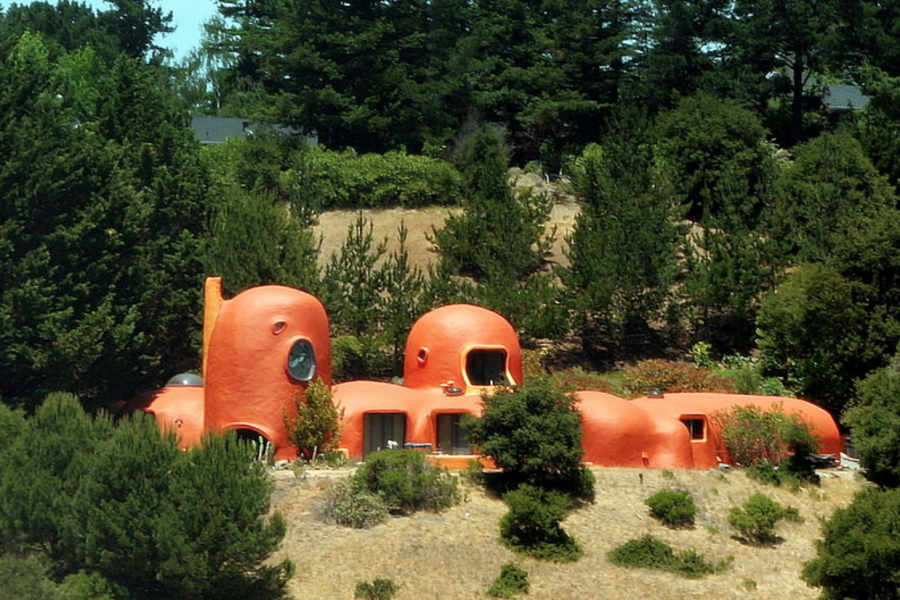The famous “Flintstone House” resides off Interstate 280 and is nearly impossible for spectators to miss. Photo courtesy of WikiCommons.
By Kate Jeffries
Just east of the Eugene A. Dorran Memorial Bridge, located on a quaint hillside off of Interstate 280 lies this distinct single-family home, nicknamed by Bay Area natives as the “Flintstone House”. It is a building that is nearly impossible to miss. Its reddish-orange series of domes with clay-like textures create an unforgettable image in the minds of those who have only passed the home once, as well as those who pass the unique Hillsborough residence everyday.
Although the Bay Area’s Flintstone House might at first seem to simply be a quirky residence in Hillsborough, there is ultimately more to the home’s history than solely its unique appearance.
The home was originally painted an off-white color when it was built in 1976. Yet, during the mid-1980s, water runoff on the steep hillside the house is perched on harshly affected the Flintstone House. The house as a whole began to sink, and its walls developed serious cracks. Many neighbors took advantage of this incident, claiming it as evidence that the house should be removed. Yet the house remained standing after welcoming a new owner in 1987. This new owner paid for extensive changes, the majority of which included a serious renovation to keep the house safe and sturdy as well. In addition to the structural improvements, the new owner also painted the home the sunset orange color it is famous for today.
The iconic Bay Area abode was designed by William Nicholson in 1976, using a trial method of construction known as “monolithic dome construction.” The term “monolithic” is used as an adjective to describe a building made from a single material which stems from the igloos which were the first homes of using this method to be created.
However, the Flintstone House was not the first monolithic dome home to be created. The first monolithic dome was constructed in Provo, Utah, and was completed in 1963 and opened shortly after as an ice skating rink due to the great isolation in the domed buildings. The building was later torn down in 2006 for new construction but is still recognized today as the birthplace of this unique method of construction.
One of the innumerable factors that make monolithic dome construction so unique includes the fact that all the walls of the home are at a slant. At the core of the curved house, the building is formed using an inflated air form, also known as an aeronautical balloon. The structure is made of rebar frame and a concrete base with the balloon on the inside of the framework.
Next, a layer of polyurethane foam is sprayed along the inside of the dome to create stability for the framework and eventually help with insulation. Shortly afterwards, a layer of concrete is sprayed on the outside of the dome which consolidates over the frame.
After the concrete is set, the machine keeping the balloon inflated is turned off and the outside of the building can be painted or decorated in other forms. Meuschke elaborated on the construction of the house, by stating that the home was so unique that it narrowed the pool of buyers. Meuschke mentioned that the home was more challenging to sell in comparison to other homes in the same area and price range. “It was on the market for almost two years”, Meuschke said.
The home was originally priced at 4.2 million dollars when it went on the market in September of 2015 according to the SF Gate. This price may seem extreme, yet it is not much higher than the median home price in the town of Hillsborough. According to Forbes magazine, the average home price in Hillsborough rests at $4,127,250, just slightly less than the original price of the Flintstone House.
The home is 2,370 square feet with three bedrooms, two bathrooms, a loft, game room, and family room with a conversation pit and view of the Crystal Springs Reservoir. The home’s price was reduced in February 2016 from its original 4.2 million to 3.78 million in an attempt to sell the one of a kind home. Yet even after the price was slashed, the Flintstone House remained on the market until it was sold on June 27th, 2017 for 2.8 million dollars according to Meuschke.
Despite the fact that to many Bay Area residents, the home is nothing more than something they pass routinely on the freeway, the home ultimately has more history than it may seem to at first. With its forward thinking, and ambitious, nuanced plan of construction, the home is representative of the Bay Area mindset as a whole, making it an essential monument of the community.








